How to train new facilitators – a step by step guide
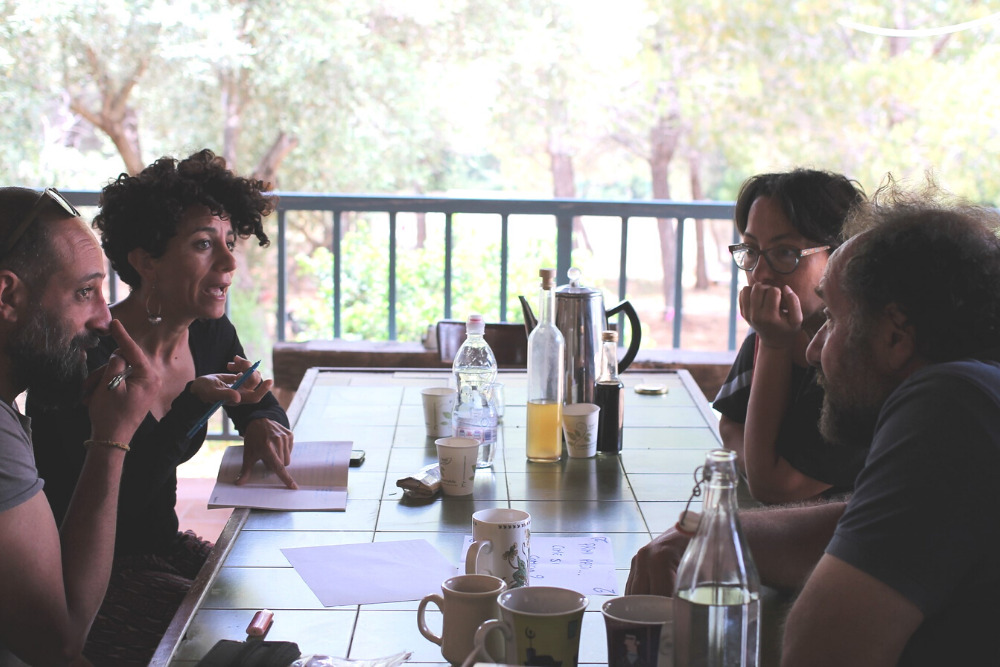
Training new facilitators in the use of facilitation skills is essential as the profession gains recognition and organizations come to realize the advantages of having facilitative leaders and team members.
But how to begin? In this piece, IAF endorsed facilitator and new SessionLab team member Deborah shares tips and tools from her experience of 5+ years introducing students and professionals to facilitation.
She leads us through the programme of a half-day introductory workshop session in which participants experience facilitation tools first-hand, reflect on them, and collect methods and skills in their first facilitation toolkit.
As a facilitator and trainer, you may sometimes be asked to reveal what is going on behind the scenes.
- Is a client looking to build capacity among staff, aiming to self-facilitate day-to-day meetings before calling you in for more complex projects?
- Have you been invited by an education institution wanting to train students to be great team players in their professional future?
- Are you personally looking for a way to share facilitation with others by creating a workshop that is engaging, actionable and hands-on?
Whatever the reason for which you are setting off in the adventure of facilitator training, you’ll find something useful in the following pages, as well as in the accompanying workshop template.
This programme for a half-day starter workshop has been tried and tested for over five years and in different settings, including online. Read on to find out the rationale behind the design, what you should be looking out for in running it, and what pitfalls to avoid when training new facilitators.
Why we should be training more new facilitators
After taking part in this training, Issam, a 26-year-old student of business and accounting, commented “I don’t plan on becoming a professional facilitator. But taking the facilitator’s point of view has really changed how I behave in meetings”. His words say a lot about why it’s so important to train more people in facilitation skills.
The need to train and enable the success of a new cohort of facilitators also emerged as one of the key findings of the State of Facilitation in 2023 report. Data collected indicates a low number of facilitators under the age of 30 (only 38 responses) and beginners (7.2% of respondents) in the field. This matches our general impression that there are actually very few Gen-Z facilitators out there.
With only a mere 3.4% of facilitators in their 20s responding to the survey, the facilitation community is left to wonder: what can we do to include younger voices, and train the next generation?
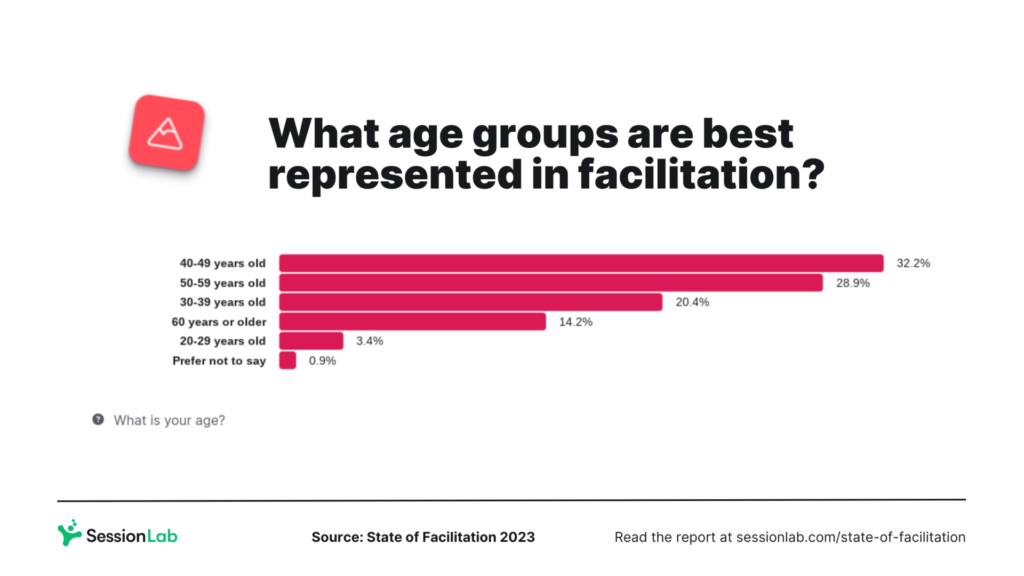
Here are three key reasons for training newbies:
- To improve the effectiveness of team projects, at a time when we need collaborative efforts on all fronts, to navigate, and steer, rapid changes in the world;
- For better workplace experiences, key in attracting and retaining a skilled workforce in the era of the Great Resignation;
- To increase the ranks of facilitators, as the profession gains traction and recognition around the world, in private and public sectors alike.
As a global civilisation we are currently facing complex or “wicked” problems in all areas of life, be it our relationship with the environment, competitive pressure, a global pandemic, a breakdown of the international order (you name it).
In order to face such complexity, we need new pathways, new ways of thinking, which might be referred to as “holistic” or “systemic”, that center around hearing from diverse stakeholders and getting all the voices in a room. Leveraging diversity, breaking silos, encouraging multidisciplinarity are the paths to the truly innovative solutions our world needs.
Diverse, multidisciplinary teams can achieve astounding results, but collaboration takes work and practice. Facilitation skills, which include the ability to steer difficult conversations, design ways to ideate together, prevent and transform conflict, and get action points done, are essential to working together in diversity.
As teams learn to work better together, misunderstandings are prevented and conflicts resolved in creative and transformative ways.
There are innumerable benefits of applying facilitation to day-to-day life inside companies and organizations. Meetings become more efficient and effective. Listening and sharing activities encourage participants to reconnect to the source of their motivation, and to one another.
Let’s be clear: facilitation alone does not make a healthy workplace, and should always be part of a wider design for well-being which could include, for example, coaching, supervision groups, or other forms of support. That said, at a time of widespread lack of motivation and engagement at work, facilitation can make a difference.
As professional facilitators, while it’s true that we may compete for specific jobs or projects, we are part of a collaborative ecosystem of professionals scattered across the globe. The more our networks grow, the more traction the profession gains. This is the basic reason why training newbies benefits facilitators. By training new facilitators we can make our professional networks stronger, and our work easier!
As each one of us grows professionally it’s common to keep getting asked to perform smaller tasks we might no longer have an interest in, such as moderating a discussion table or an individual meeting. There will always be a scattering of smaller scale projects that we can pass on to newcomers. In another scenario, someone less experienced might work alongside a more seasoned facilitator, taking care of tasks such as minute-taking or just general support.
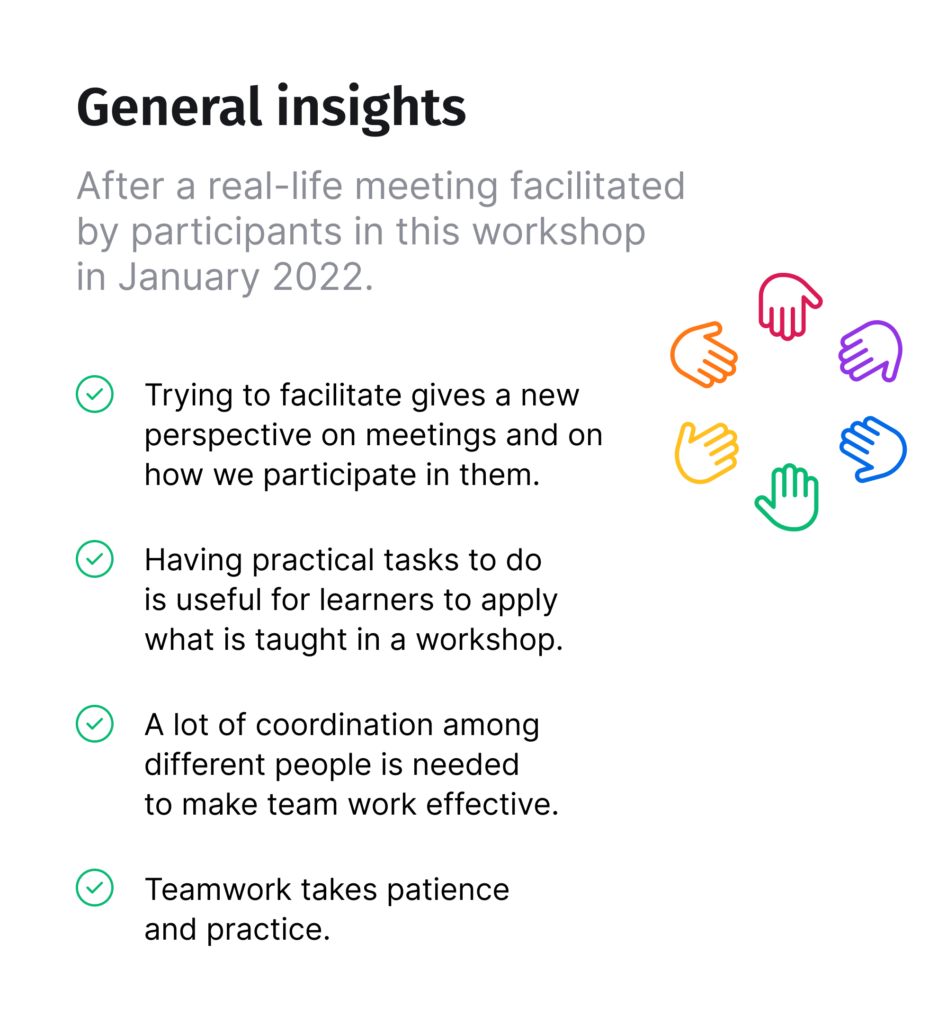
When describing what I do as a facilitator, I am often asked: “What did you study?” “How did you start?”. Colleagues in the field have the most varied professional backgrounds. A geologist, an economist, two engineers, an architect, and a marketing major are among the facilitators I most often collaborate with.
Facilitators tend to have picked up their knowledge in practice, in many short-form trainings and/or by shadowing more experienced colleagues. So… how does one start?
A scattering of higher education institutes have begun to offer courses related to facilitation (such as the MSLS in Strategic Leadership in Karlskrona, Sweden) but this varies greatly around the world. There are plenty of training courses to choose from, offered on and offline, on specific methodologies, or in-depth year-long courses.
That said, there are currently not many opportunities available for facilitator training. If you are called to help fill this gap by offering starter workshops to newbies, you can be sure that your offer will attract participants and respond to a very real need.
A word of advice about how to position or advertise your workshop: despite being a growing field, facilitation is still a novel concept for many. Furthermore, it’s risky to give the impression that anyone will be able to facilitate with confidence after a short introduction.
For these reasons, rather than aiming to train all-rounded professional facilitators, start by framing your session as sharing facilitation skills, to be applied in many different contexts. Because the most common application is going to be in meetings, facilitating effective meetings is an attractive focus to begin with.
What to keep in mind when designing for new facilitators
The best way to fall in love with facilitation is by experiencing it directly. Conversely, the worst mistake you can make when designing a training on facilitation is to revert back to old-school, formal ways of imparting knowledge, such as lengthy presentations.
Your workshop design should allow participants to feel the magic of group dynamics. It will be, in other words, an experience of facilitated learning.
In designing introductory trainings, here are four key principles to have in mind:
- Keep it simple: methods and tools modeled and taught should be easy to replicate by anyone with “a good mind and a good heart” (to quote Open Space Technology creator Harrison Owen).
- Connect to experience: from start to end, punctuate the schedule with moments that connect to participants’ real-life experience.
- Practice, practice, practice: make space in the workshop to try out new tools and skills in a safe environment, rather than just hear about them.
The fourth principle, “open the door to a new world” is admittedly the trickiest. As a trainer to newbies, you will inevitably be walking a fine balance between empowering participants to take action, and reminding them that a half-day workshop is not enough, and that there is a lot more to learn.
A good workshop design can support you to keep this balance by including space for action planning as well as for the trainer (you!) to share tips and stories. Even the simple act of having a few books on facilitation lying around the workshop space opens participants’ imagination to the rich world they are peeking into.
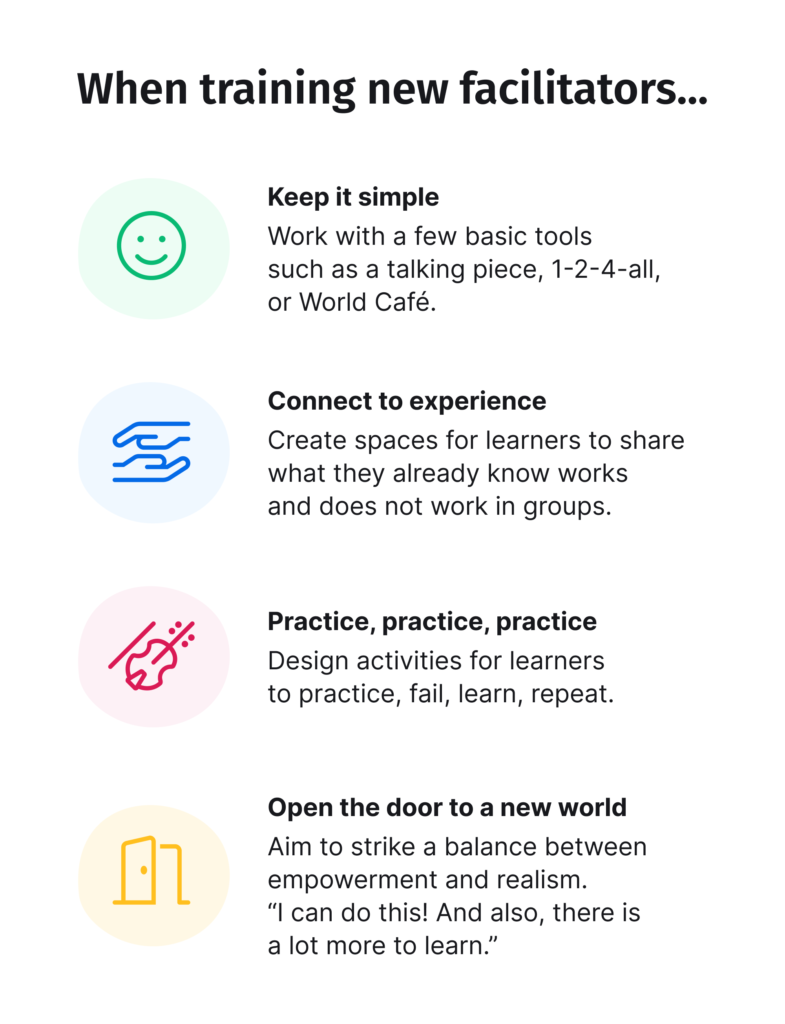
How to run the Facilitation for Beginners workshop
This half-day workshop is designed to introduce facilitation while experiencing it and reflecting on the subject. It includes:
- Space for participants to reconnect to what they already know about the topic.
- Sharing your insights and knowledge on what facilitation is (and isn’t).
- Allowing trainees to experience some basic tools and methods such as using a talking piece, World Café, 1-2-4-all, energizers.
- Learning what those tools and methods are for and when and how to use them.
- An action plan on putting facilitation into practice.
Progress through the various activities is iterative, and based on Kolb’s cycle for experiential learning. In this model, activities are followed by debrief for reflection, leading to generalization (theory, framework, “when to apply this”) and moving towards practicing new skills in the real world.
The schedule includes three main blocks, each building upon what was learnt before.
- Part 1 – Practicing active listening
- Part 2 – Basic elements of facilitation
- Part 3 – Facilitating effective meetings
Put together, these form a coherent starting kit that can usher a rookie into the world of facilitation. Each activity serves more than one purpose: participants experience facilitation while talking about facilitation. This makes for a rich, multi-layered experience.
There is a small risk that people may get lost, and you should address this in the introduction by explaining that trainees will find themselves in different roles: participants in the activities, and budding facilitators reflecting on what they have just done.
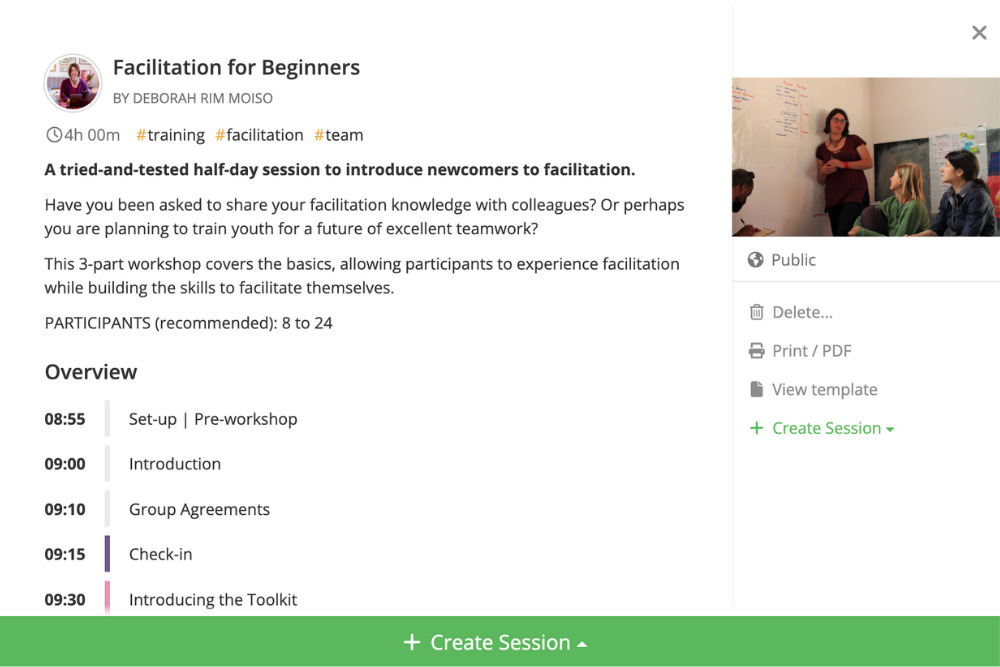
Part 1 – Practicing active listening
Many skills are needed to be an effective facilitation, but arguably number one is the ability to listen intently, and actively, without rushing to conclusions or preparing to debate.
The first section of this workshop introduces participants to this key skill in a paired activity. As an added bonus, the topic they will be focussing on, and sharing with another participant, is their own experience with group work.
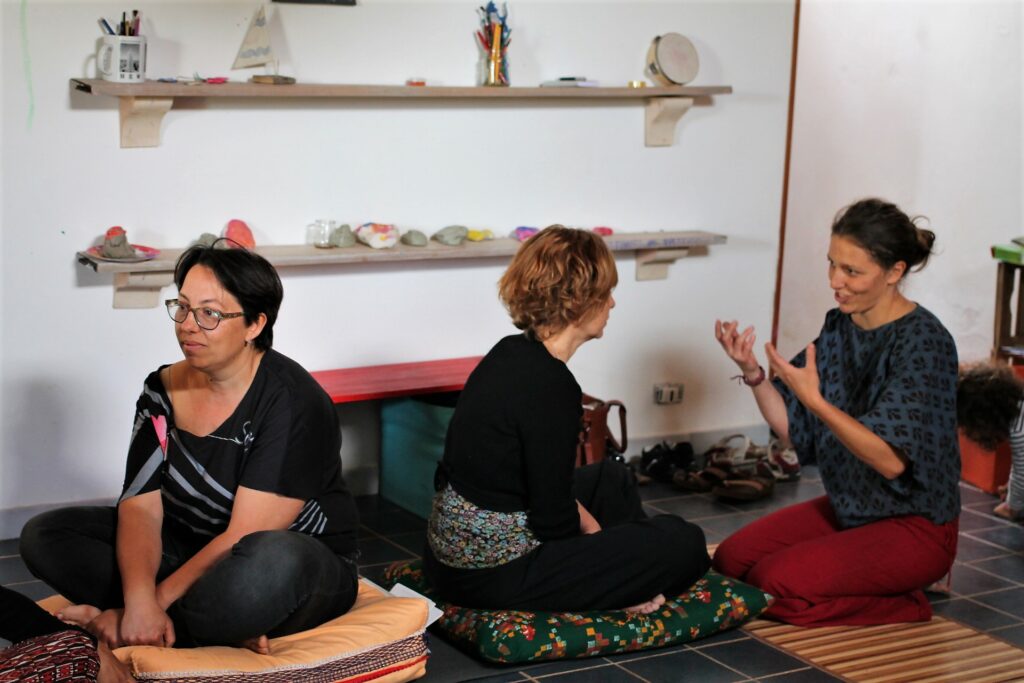
Part 2 – Basic elements of facilitation
Having flexed their active listening muscles, participants at this point are likely to be ready to hear more about facilitation itself.
Before sitting back and hearing from you, they prepare by tapping into the knowledge already present in the group using the 1-2-4-all format. Trainees thereby gain experience of this basic, versatile tool from the suite of methods known as Liberating Structures, which include some of the easiest activities for participants to facilitate themselves, after the workshop.
The core of this session includes a video and a presentation on facilitation. Here is where you will give participants key pointers on subjects such as:
- acknowledging that facilitation is a skillset as well as a profession
- explaining the facilitator’s position, neither in nor out of the group
- clarifying the differences between facilitating, coaching, mediating, training, consulting
- real-life stories and examples of facilitation’s impact, ideally in a sector that will resonate with participants
- introducing a simple model on group dynamics, such as Tuckman’s (forming, norming, storming, performing, adjourning), and illustrating how the facilitator helps groups journey through the various stages
It’s important to remember to bring some clarity to the different roles of coach, facilitator, trainer, consultant, mediator, and so on—not only because it is a frequently asked-about topic, but because you will be acting as both trainer and facilitator in the workshop, and this can be confusing.
A great way to avoid this pitfall is to work with a co-facilitator, one of you providing content and the other facilitating the activities. If that is not possible, you can still mitigate the risk of confusion between the roles by making this explicit to participants or, if you want to get creative, literally wearing “different hats”!
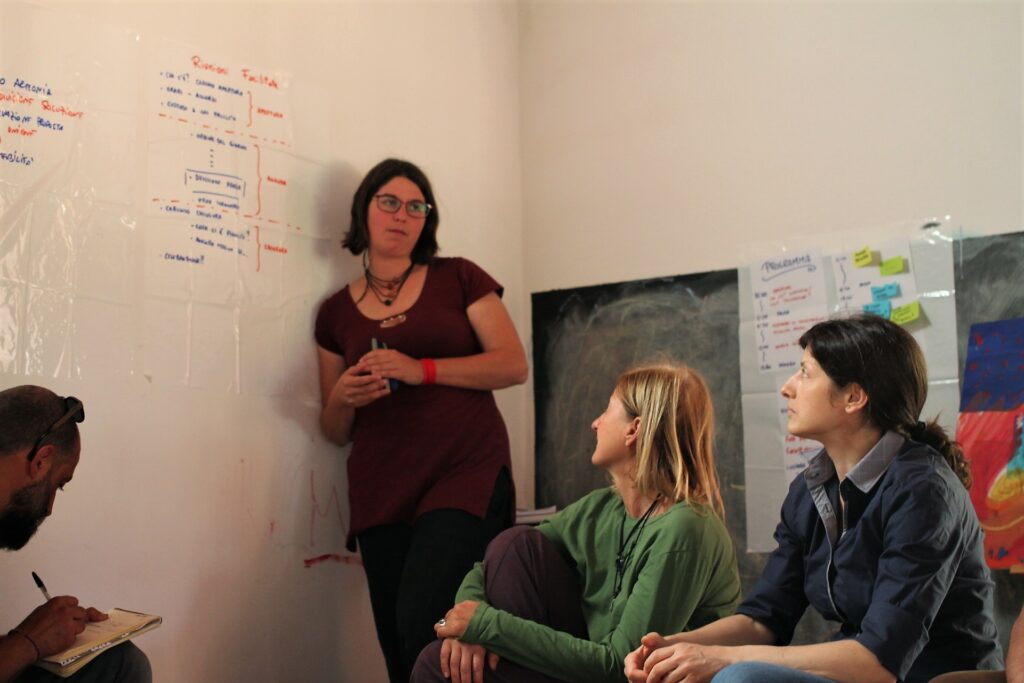
Part 3 – Facilitating effective meetings
The third section of the workshop is focused on running effective meetings. Meetings are likely to be the first place facilitation skills are applied by newbies. Most people can relate to the difficulty and stress of participating in badly designed meetings. This is a context in which small changes can lead to dramatic improvement, making it a good place for beginners to build up their facilitation muscles.
Shape this talk based on your experience. Recommended topics include:
- The importance of check-ins
- How to structure an agenda
- Breaks & energisers
- Different roles in a meeting (e.g. facilitator, time-keeper, note-taker…)
- Check-outs and collecting feedback
The I DO ARRT mnemonic is beloved by most beginners. It’s a reminder to start every meeting by sharing the following information as a group.
- I Intention
- DO Desired Outcome
- A Agenda
- R Roles & Responsibilities
- R Rules
- T Timing
After the talk, use a World Café to make space for discussing how meetings can be improved with facilitation skills. With such a practical challenge to face, expect participants to get to work with passion and the energy in the room to rise.
The toolkit: where the magic happens
Reflecting on an experience is the key to effective learning. To support this in your workshop for beginners at facilitation, set up a simple, yet highly effective support: a poster, or whiteboard space, clearly titled Toolkit.
During the workshop, participants experience facilitation skills, tools and methods: this includes the abilities you model, as well as the practical activities they take part in. If we were simply packing activities one after the other, the day might feel airless and rushed, and learning less likely to “stick”.
Avoid this risk by punctuating activities with moments of reflection. At those times, ask “what tools, skills or methods have we experienced?”. Collect answers from the group and write them all up in the Toolkit. In a second column, add some pointers on why and when a facilitator might use these tools.
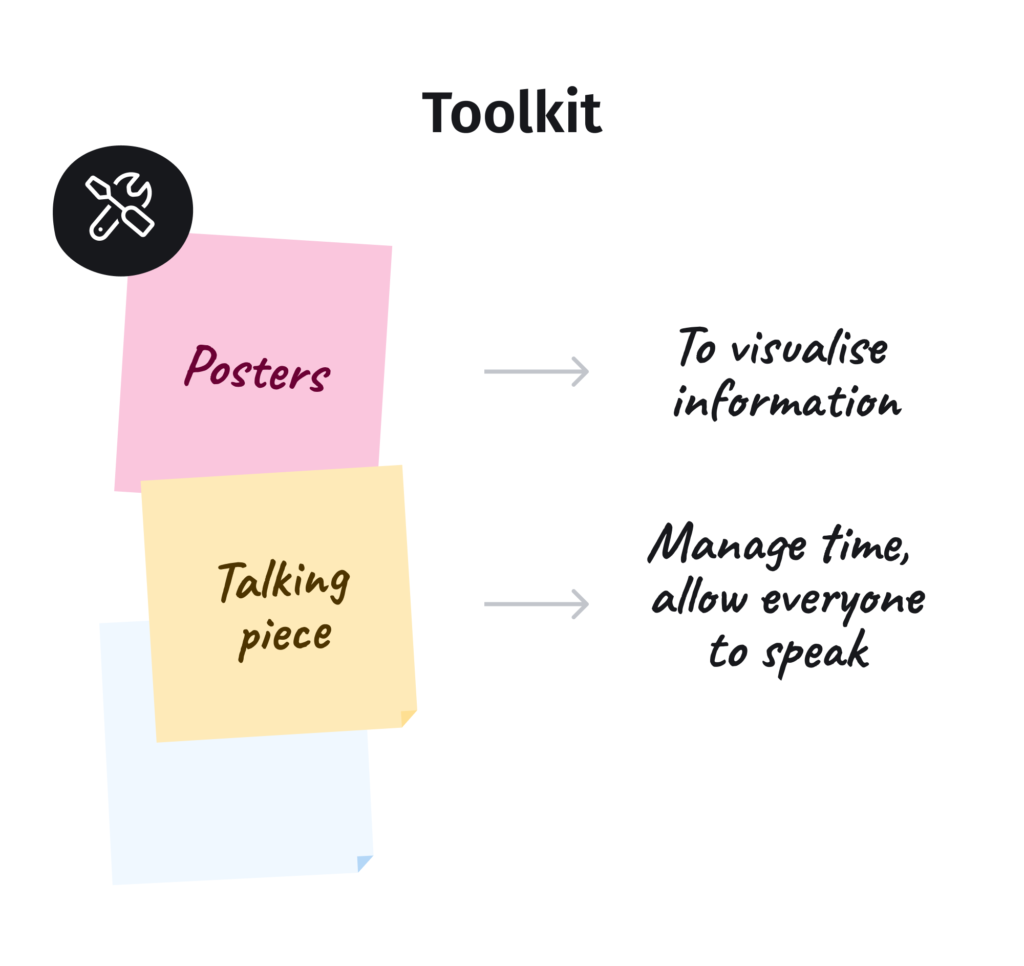
The workshop opens with a series of activities to help form a setting conducive to group learning, such as a check-in, setting group agreements, and using posters and sticky notes. Therefore, the toolkit will quickly be populated, from very early on.
As the day progresses, you will be adding some basic tools (talking piece, timer), then skills (active listening, time management), and lastly more structured methods (1-2-4-all, World Café).
Past participants have gotten creative, adding entries such as the choice of venue, the bells with which I mark time, and even the colorful markers I was using to write on the Toolkit itself!
Toolkit checkpoints create a space for reflecting, learning, and illustrating visually the material covered. The list grows during the day, making the invisible treasure chest of tools clearly visible.
By the end, participants marvel at how much they have already added to their stash. An Action Plan session in the closing section is enriched by the possibility of referring back to the Toolkit, by asking questions such as: what three entries from the Toolkit will you be putting to use within the next month?
How to run this session online
In running this session online, you can keep the same structure and sequence of activities, but here are some tips to keep in mind:
- Timings will change a bit, as people will take a while to get familiar with the technology. Add some time at the beginning to make sure everyone is comfortable with the tools you are using. Share your screen to show participants the whiteboard and place a getting-to-know-you activity there so that they can start learning how to navigate the board and add their notes.
- Group work sessions, on the other hand, can be shortened, as less time is spent in moving around space and changing settings.
- As you are showing these newcomers to facilitation how things work behind the scenes, take time to explain how you are using the technology and share tips on remote facilitation, for example on how to create breakout rooms. What are the basic tools you are using? Those are likely to be the same ones your participants may need if they try remote facilitation themselves.
What to do after the first workshop
A learning journey into facilitation might start with a beginners’ workshop, but it certainly does not end there. Support your participants as they go forth into the outside world by:
- Sharing copies of your slides and summaries of the methods used.
- Providing a bibliography and recommendations on where to learn more.
- Offering follow-up workshops. Topics that make sense are group dynamics and decision-making, though asking participants what would be useful to them is a great next step too!
- Certifying the skills they have learned. Even if you do not represent an organization, a certificate will still have value for your learners. Here is one we’ve created for participants in the Facilitation is For Everyone Email course, which you are welcome to join!
- (Particularly if working with youth) keeping in touch with those you think show the most promise and may want to make a career out of facilitating: encourage them, consider inviting them to shadow you or lend a hand with the practicalities of your next effort.
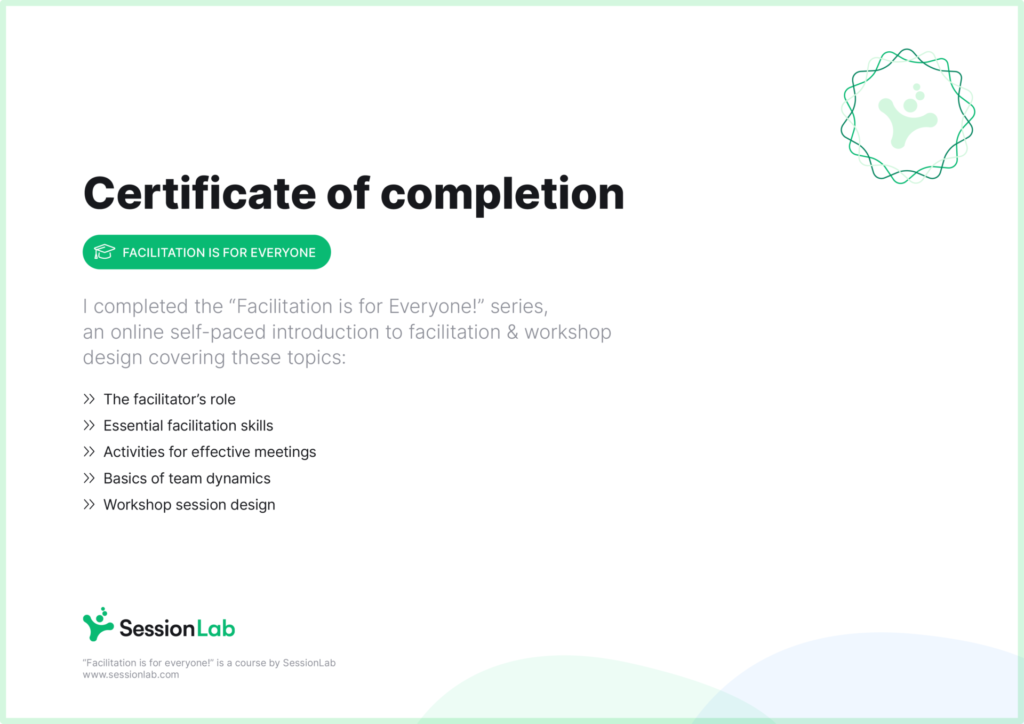
Tips for training new facilitators
Here are some general guidelines and insights from my experience running workshops with beginners.
- Keep your session short: it’s reasonable to have a half-day, maximum one-day workshop to begin with. This will make it more accessible for people who are curious. With this workshop you are opening the door: the rest, such as immersive three-day or week-long courses, can come later.
- Your participants are likely to have skills and methods that can be used to facilitate, even if they might not call them that. Validate the knowledge they bring about working in groups, whether it comes from family outings, school projects, a theater group, a startup team, a community project… These experiences are the foundation of their future facilitation excellence.
- Share stories and anecdotes from your own work. Newcomers to facilitation may come with a sense that it’s utopian or impossible; sharing your experience opens a window into what is truly possible.
- Find every opportunity to invite participants to lead the group and practice in short, safe situations. Is someone a yoga teacher? Ask them during lunch if they are ok with leading a short breathing exercise to restart after the break and encourage them to try (but do this in private, rather than putting them on the spot in front of everybody).
- If you feel the group needs more time on a method or has many questions, slow down. You should not assume you have to cover the subject in its entirety and rush through the session with the risk of leaving people confused or overwhelmed. Better to train newbies in one or two tools, until they feel confident in using them and excited to learn more.
In closing
Working with new facilitators can be extremely satisfying. For me, it’s a constant reminder of the power of facilitation to improve (or revolutionize!) people’s personal and professional lives.
As we have seen with the story of Issam, who took a more proactive stance in meetings after getting a taste of what it’s like to lead them, not everyone can be a facilitator, but anyone who works with other people, on any project, wherever they are in the world, can benefit from improving their facilitation skills. You could be the one to usher that change, so go for it!
If you work on training new facilitators, one book you cannot miss is George Lakey – Facilitating Group Learning, Strategies for Success with Diverse Learners!
Do you run facilitation workshops for newbies? Have you tried out this template? If you have found this article useful, share your comments and stories, I’d love to hear from you!
Are you beginning your journey in facilitation? Join the 5-part free email course Facilitation is for Everyone and get tips and activities delivered to your inbox every Monday!



Leave a Comment